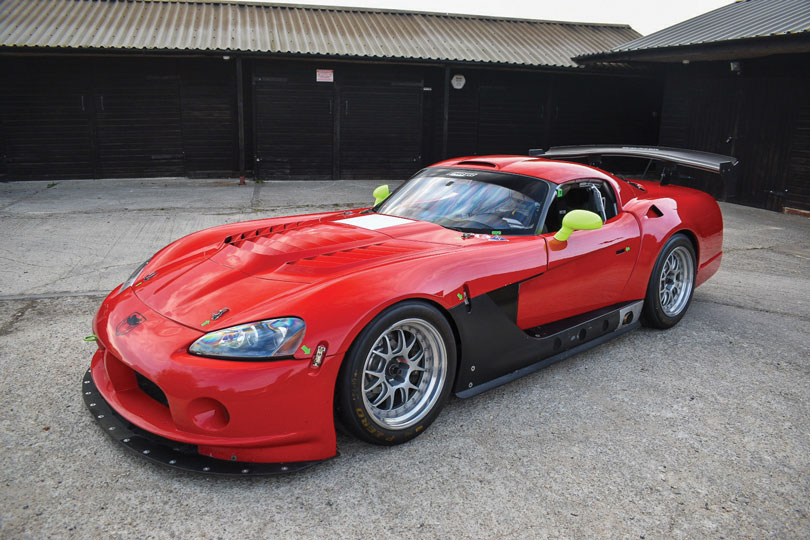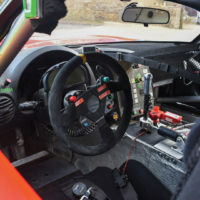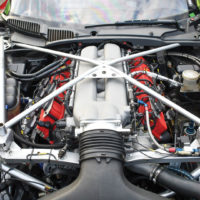- Originally built in 2008, this Viper GT3 was initially raced in the British GT by Aaron Scott and Craig Wilkins. It was subsequently repurposed for the 2011–14 Dutch Supercar series and appeared in the U.K. again in 2018 to contest the GT Cup in the hands of David Krayem and Speedtec Motorsport.
- Under the bonnet is a 650-horsepower, 8.4-liter V10 racing engine, which is as-new with 50 miles of shakedown use only, coupled to an EMCO sequential transmission with Geartronics paddle shift.
- Finished in bright red, this Oreca-built Viper is fitted with the full GT3 aero kit, including a prominent front diffuser, side skirts and the “kamm tail” rear end that is unique to the racing version. There is also a substantial rear wing.
- A significant spares package comes with the car, which includes — but is not limited to — dampers, brake pads and discs, bodywork, wheels and tires, radiator, coolers, steering rack, lights, differential and drive shafts.
SCM Analysis
Detailing
| Vehicle: | 2008 Oreca Dodge Viper GT3 |
| Years Produced: | 2006–09 |
| Number Produced: | 100 (approximately) |
| Chassis Number Location: | Left A-pillar |
| Engine Number Location: | Front right of block |
| Club Info: | Viper Club of America |
| Website: | http://www.viperclub.org |
| Alternatives: | 2006–09 Callaway Corvette Z06R GT3 2006–09 Porsche 911 GT3 Cup 2006–09 Kessel Ferrari F430 GT3 |
This car, Lot 5894, sold for $99,054 (€73,140), including buyer’s premium, in a Collecting Cars’ online auction on October 3, 2021.
In my years around this business, I have come up with a couple of axioms about the auction world. First, a reminder that any racing car can be thought of as a combination of “collector” values (historic importance, beauty and rarity), and “weapons” values (how much fun can you have playing with it). In today’s world, a Ferrari 250 GTO is almost entirely comprised of collector value while something like our subject 2008 Oreca Dodge Viper GT3 has almost nothing beyond weapons value.
Thus, my two axioms are:
1. If you have a purely weapons-grade racer and want anything more than to get it out of your life, an auction is a terrible place to sell.
2. If you are smart, knowledgeable, patient and a little brave, an auction is a great place to score an excellent buy on a car that shouldn’t have been sold that way.
I won’t get into the details of the first point here; suffice it to say that there are lots of reasons, both intuitive and observed, that this is the case. An auction environment is simply not conducive to resolving the insecurities and concerns needed to pay top dollar for a used racing car. From this, it follows logically that if you know what you are doing, opportunities are occasionally there for the taking.
From road to track
Let’s talk about racing Vipers. Dodge introduced the Viper RT/10 in 1992, the idea being to produce a “modern Cobra.” Like the Cobra, the Viper was originally a moderately spartan open car that screamed “race me!” Chrysler tried to do so almost immediately. Unfortunately, the Viper RT/10 proved to not be very good at racing; the open chassis wasn’t stiff enough for the horsepower, weight and tires that the Viper offered, and the sort of professional racing development that it needed wasn’t available.
The Viper sold well in the U.S. (though it disappointed in Europe) and in 1996, a coupe version was introduced: the Viper GTS. Chrysler decided to get serious about racing, particularly to bolster European sales. In those days, the serious GT racing over there was FIA GT1, a class which allowed huge modifications to racers that carried the basic bodywork and engine of production GT cars. Chrysler contracted with Oreca, a French race engineering team, and Reynard, a British race constructor, to create what became known as the Chrysler Viper GTS-R (Dodge didn’t sell cars in Europe then.) Reynard built the chassis and related bits, Oreca assembled them into complete GT1 racers and lent race support. They were extremely successful between 1996 and 2001, winning virtually everything before Chrysler pulled the plug, as the program was just too expensive.
A second life in GT3
The cars continued racing with privateers well into the 2000s, moving into a less-demanding class called GT2. Starting in 2006, a new racing class was introduced, called GT3. It was oriented more toward amateur and semi-pro drivers, with moderately developed production GT cars from various manufacturers allowed, but with limits on weight, horsepower and aerodynamics to keep everyone competitive. The options ranged from lightweight, small-engine racers (Porsche, Ferrari) to heavy, big-engine beasts (Viper, Corvette). It proved to be a successful series, both in Europe and the U.S.
With all its development experience with the GTS-R, Oreca was in excellent position to construct the new GT3 racing Vipers. These were now called the Viper Competition Coupe (VCC), though Riley and Roush, among others, made their own versions. Apparently well over 100 were built. With their relatively unstressed 8-liter V10s and sequential racing transmissions, they proved to be wonderful racers, fast, dependable and safe. GT3’s rules made it more of a driver’s series than one that favored any particular car; the Viper was neither better nor worse than its competition.
The GT3 series still exists, but any car’s GT3 homologation legality expires at seven years. All the early cars like our subject car have long since departed “real racing,” but there are still plenty of places to go play. Nominally historic race operations like SVRA and HSR have available grids in the U.S. and there are active venues in Europe, as well as the usual track-toy events at most racetracks. There are no shortages of things to do with a car like this.
Bargain-priced barnstormer
Addressing questions of price and value for this car is a bit of a challenge. My immediate response (along with several colleagues) was, “Wow! That’s cheap!” Considering the amount of sheer track muscle that this car offers and the relatively low costs to run it, a sub-hundred-grand result seems like a wonderful deal. Think about it: You’ve got a fresh 650-hp engine in a professionally prepared racer with all the bells and whistles, huge tires, great brakes, and a strong-enough chassis that you are unlikely to get hurt if you make a mistake. A weekend is going to cost you a set of tires, half a set of brake pads, fuel and gas, and maybe $1,000 toward the next mechanical rebuild. That’s not bad.
The other way to look at things is to consider your options. There are plenty of GT3 racers available if you really want to buy one, and they are all good cars. My sources tell me that the basic range runs from Ferrari at the high end through Porsche on the low side. A Ferrari 458 GT3 with racing spares will be about $180,000. Porsche built a ton of GT3 racers, so they are relatively plentiful at around $70,000. As an American, relatively heavy, high-horsepower racer without the Italian “cool” factor, the lower middle of the value range seems about right.
It still seems like an incredible amount of bang for the buck, and I can’t help but feel that properly marketed through a reputable broker, the car could have brought a substantially better return. I don’t know the seller’s motivations or circumstance, though, and if you are not too proud about the price, an auction can provide an immediate sale versus waiting for months or longer. As it happened, the seller’s choice was an auction, one that resulted in the car being well purchased. ♦
(Introductory description courtesy of Collecting Cars.)




